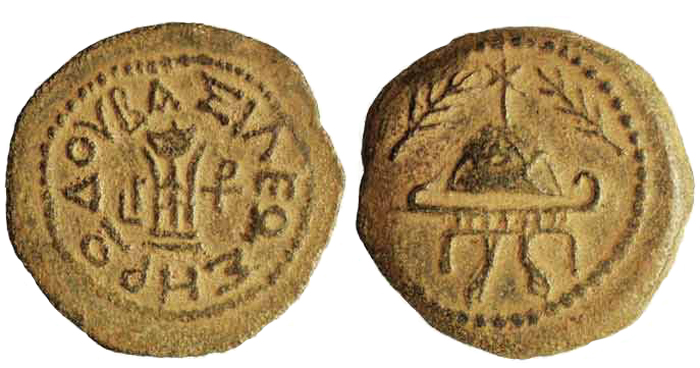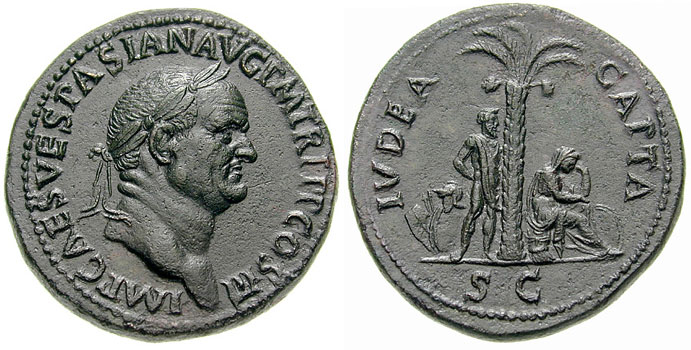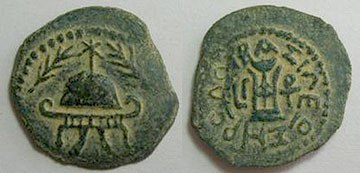Oh my, hit the jackpot!
The Coins of Herod: A Modern Analysis and Die Classification, by Donald Tzvi Ariel, Jean-Philippe Fontanille, (Brill, 2011)
[124] ...
7.2. The symbol L (and letter Γ)
The symbol L (representing έτος [=year]) was well known in the East. The symbol L is found both in the 21/20 BCE inscription from Jerusalem (LK; Isaac 1983:86) and the official stone scale weight dating to 9/8 BCE (LΛB; Meshorer 1970b:97-98). The appearance of the year in the left field together with the L symbol is also found in near-contemporary coins of Demetrias (years 1, 3 and 22), Akko-Ptolemais (39/38 and 35/34 BCE), Dora (34/33 BCE) and Marisa (57 BCE) as well as other mints that are further afield.
7.3. The Ᵽ monogram
The monogram is apparently a ligature comprising the letters tau and rho (Ᵽ). It has been interpreted in nine ways, some very improbable. Nevertheless, all are presented below, in the chronological order that the interpretations were suggested.
1. 1850: crux ansata (a life-symbol of the ancient Egyptians). The idea was proposed by Cavedoni (1856:56).
2. 1855: τριάς or τρίχαλκον. This is Greek for ‘three’ or ‘triple-bronze’, implying the symbol refers to a denomination. De Saulcy (1855) suggested this in conjunction with an idea that two letters seen by Akerman (1846:135, Nos. 5-6) on a Type 2 coin should be read as ΔΙ and interpreted, together with the X on the Type 5 coin, as δίχαλκον (= double- bronze). The entire proposal was quickly rejected (Madden 1864:86-87), and the rejection may now be said to be final with the full die sequencing of the LΓ coins (Pis. 4-33), without any additional letters.
3. 1926: Τιγράνης. Hunkin believed Tigranes to be “an officer in charge of Herod’s mint, otherwise unknown,” and noted that the name occurred in Herod’s own family (Hunkin 1926:300).
4. 1936: Τραχωνῖτις (Trachonitis). This reading was suggested by Narkiss (1934:9-10; 1936:33-34) [125] and Reifenberg 1947:18. Trachonitis was not a particularly important region in Herod’s kingdom (Kanael 1951-1952:263). It was added to his kingdom at the same time as Batanea and Auranitis. Even if the receipt of those territories from Augustus were to be noted on a coin of Herod, it would make no sense for the Ᵽ monogram to indicate only one of the three gifted territories. See section 5.2 above.
5. 1942: τρίτῳ ἔτει. This is Greek for ‘in the third year’, as a duplication of the year-three denoted by the LΓ in the left field. Kanael 1951-1952:264 (and, roughly, Kanael 1963:48) proposed this reconstruction, explaining that Herod “intended to stress the fact that he was legally king even during the years...when Antigonus ruled.”
6. 1959: Τύρος (Tyre). This fanciful proposal was proffered by Meyshan (1959:115 n. 4). Richardson (1996:212) viewed the idea as plausible. When not depicting the club, palm tree, ambrosial stones and conch as a mintmark, Tyre had one distinctive letter mint mark comprised of a monogram ([a combination of Y+T+P]) surmounting a club, which is quite different from the Ᵽ monogram. See section 5.2 above.
7. 1981: Cross (+) and rho (P). Krupp and Qedar maintained that the ligature represented a cross and rho, where the cross was the same symbol as in the diadem, and stood for eta, the first Greek letter in Herod’s name. For the cross, they based themselves on a coin published by them, reading BACIΛ/ ΕΩΣ+/ΡΩΔΟΥ (Type 11, dies 020-R40; Krupp and Qedar 1981:18). The cross and rho ligature was then equivalent to H and P, meaning Ηρώδης (Krupp and Qedar 1981:18). Kokkinos accepted this decipherment, relying upon monograms from the Ascalon mint which, he believed, related to Herod’s ancestors (Kokkinos 1998:130-132; section 2.4 above). Kokkinos went on to interpret the Ᵽ monogram on Herod’s LΓ coins as the Herodian family’s “standard mint mark” (Kokkinos 1998:130). One might ask why the eta rho ligature (HP) for Herod’s name found on his official stone weight (Meshorer 1970b:97) was not used. An additional problem with Krupp and Qedar’s idea is that Herod’s name already appears in full on the coin.
8. 1981: Without deciphering the Ᵽ monogram (as in No. 3 above) Rappaport (1981:365) said it signified the mint-master (section 5.2 above). Later, Richardson said the Ᵽ monogram must have signified the location of the mint (like Nos. 4 and 6 above) or the mint-master (Richardson 1996:160 n. 31). Without doubt, the location of the mint should not be established only on the basis of an interpretation of this monogram. If, in fact, Jerusalem was the mint of these coins, as we have concluded (section 5.2 above), there appears to be no obvious connection between the Ᵽ monogram and the name of that city.
9. 1982: τετρήρχης. Meshorer (TJC:62) noted that Ptolemy, the Iturean king of Chalcis, was a tetrarch and also inscribed Ᵽ on his coins. The coin in question (Kindler 1993:286, No. 6), dates to 63/62 BCE, and Ᵽ appears in the right field as on the LΓ coins. Meshorer interpreted the Ᵽ monogram on Ptolemy’s coin as standing for the Greek word for tetrarch. This is reasonable, as this coin of Ptolemy is one in which an inscription noting the king’s status as tetrarch is absent. Meshorer interpreted the Ᵽ on Herod’s coins to mean tetrarch as well, and used this fact to support his dating of the coin series to 40 BCE (section 5.2 above). Liampi (1989:39) accepted that the Ᵽ monogram meant tetrarch. Ptolemy’s monogram, however, is an isolated instance. While this interpretation is an improvement over Rappaport’s poor use of a 75-year-old parallel (section 5.2 above), Ptolemy nevertheless ruled more than 20 years before Herod. His other coins did not bear this monogram; nor is it found on coins of numerous other contemporary tetrarchs.
...
[126] In our opinion, the monogram should he taken to be an abbreviation of a person’s name, as was common on ancient coins. The closest view to this above is Rappaport’s (No. 8); he suggested that the monogram signified the mint-master’s name. It would he better to view the monogram as the symbol of the magistrate (in later periods called a liturgist; Harl 1987:27) responsible for the coin issue. As in other mints in the region, this was the person — often unidentified — who supervised the production of the issue (Kushnir-Stein 1999:197). While we cannot reconstruct his name here, we may suppose he was closely associated with Herod. In the southern Levant, unidentified monograms and abstract symbols are the rule, not the exception.
Explanation #5 for the monogram consisting of a T (
tau) and a P (
rho) would date this to 37 BCE as you had understood it, but if L (symbol for "year") Γ (Greek letter
gamma = number 3) in the left field means "Year 3" (and it almost certainly does) then why use a monogram that says essentially the same thing in the right field?. Explanation #9 makes better sense to me, but what does "tetrarch" mean? When he and his brother Phasael were made such (essentially glorified procurators over Judea/Samaria while Hyrcanus was the HP and "ethnarch") by Marc Antony in fall of 41 BCE, so yr 3 means 40/39 BCE, or was this some sort of way of designating Herod "king" by appointment of the Roman Senate on 40 BCE, where yr 3 means 37 BCE? But why not just call him "king"? To call him a "tetrarch" would seem like a demotion.
I think that maybe the date of this coin was more like 39 or 38 BCE, when he was churning out pocket money (he did not issue any silver money, but used the drachmas in general circulation or Roman denarii of his Roman patrons) to get his name out there as the remaining "legal local ruler" (now that his brother was dead), and grease the local economy, until he could unseat the currently ruling Antigonus. The Romans may have really told Herod that he was "king" if, and only if, he could unseat Antigonus. Until then, he fell back on his previously bestowed designation "tetrarch".
DCH (and may Brill forgive me for the extensive citation, made in the spirit of investigative study, otherwise it may be purchased for a mere $175 - but for that money, maryhelena, you at least get a hardback)



